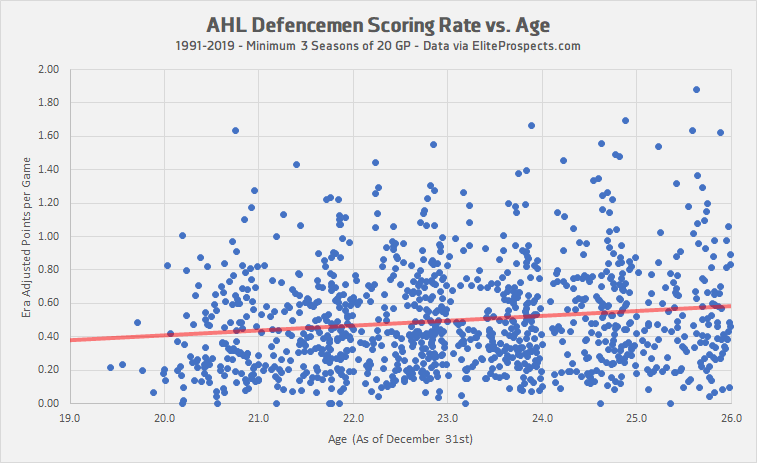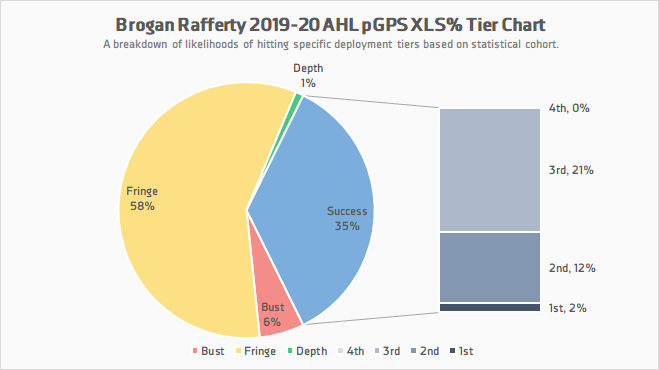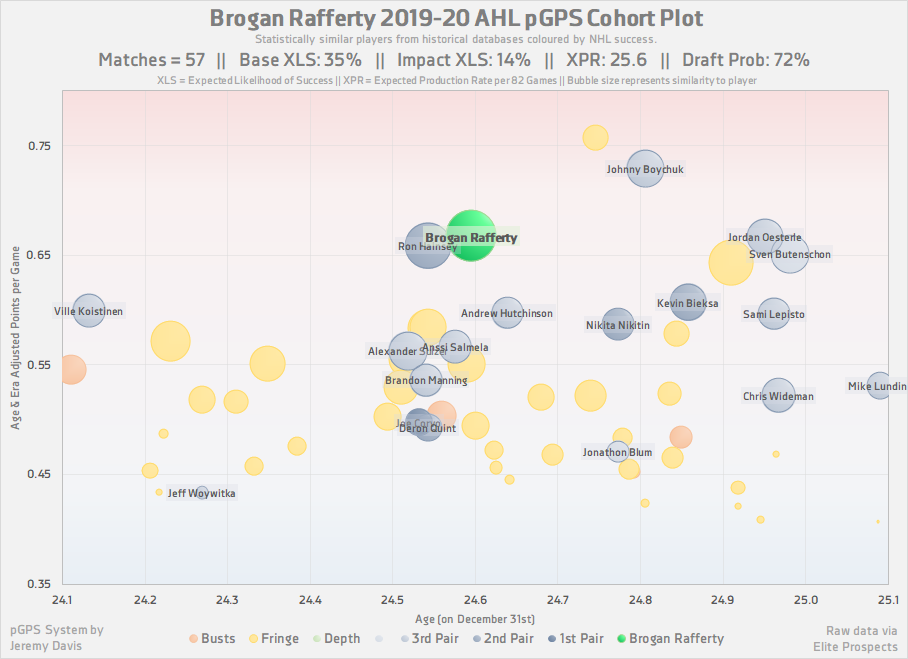It’s time for patience and reasonable expectations when it comes to Brogan Rafferty
By Jeremy Davis
4 years agoWhen the Canucks signed Brogan Rafferty and Josh Teves out of college last Spring, it was already found money. College free agents are often like picking up wallets on the side of the road – sometimes they contain two bucks, other times you might find a thousand in there. Regardless of the outcome, you might as well pick it up, because it doesn’t cost you a thing except the effort to bend down and reach (we’ll also pretend that we live in a world where trying to find the actual owner of the wallet isn’t the right thing to do).
Some of the college free agent wallets the Canucks have picked up over recent history have been pretty empty (such as the briefly hyped Griffen Molino) but others have worked out marvelously, like Troy Stecher or – the crown jewel – Chris Tanev.
Josh Teves looks a bit like a Molino, but Brogan Rafferty looks an awful lot like an NHL calibre defenceman. In his rookie season in the AHL, Rafferty is blowing the doors off in terms of production and generating some eye-popping highlights.
All of this hasn’t been lost on Canucks fans and media, many of which are now clamouring for Rafferty to get a spot in the lineup. The media contingent is linked to TSN’s Rick Dhaliwal. Given Dhaliwal’s connection to sports agents, you can bet that this is coming directly from Rafferty’s camp.
There are just a couple of issues: one being that the Canucks don’t actually have room in their lineup and would have to go through the unsavoury exercise of scratching a regular, and the other being that Rafferty is quite old for a professional, and that is certainly going to affect his projected career arc. I’ll explore both factors in depth here.
I’ll note also that I’ve been meaning to put together a deep dive on what the Canucks have in Rafferty. This is not that article – today’s purpose is simply to readjust observer expectation; the full breakdown will have to come at a later date, if I can find the time.
Room on the Roster
As mentioned, issue number one is that in order to get a look at Rafferty in the NHL lineup, someone else needs to come out. The right side of Chris Tanev, Tyler Myers and Troy Stecher is certainly the deeper of the two sides – the bottom spot on the left side is basically up for grabs right now, but the right side is pretty set and it’s unlikely that any healthy scratches are coming for those three players. In Vancouver, injuries to the back end are as predictable as death and taxes, and yet all three of Tanev, Myers and Stecher have played all 48 games this season.
Despite Travis Green’s apparent lack of trust in Stecher this season (as evidenced by his reduced overall ice time and declining deployment late in games), Stecher’s underlying profile remains strong. The fact that he has maintained a 49% shot share while primarily playing with Jordie Benn (43%) gives credence to the idea that he’s been underrated and underappreciated this season. Assuming that a rookie like Rafferty, dazzling as his offensive numbers are, can come in and replicate or improve upon those numbers is a bit naive.
Even when the Canucks have reached into the farm for a right handed defenceman (such as when it looked like Tanev would miss some time), they chose Jalen Chatfield. This should tell you a whole lot. Often times, the player that the team chooses to call up isn’t the best long term NHL option, but someone that they can afford to sit in the press box and spot in with minimal minutes as necessary. These are typically players that aren’t in their long term plans. The fact that they haven’t done this with Rafferty is a key sign that they see him in their future plans.
The scuttlebutt as it pertains to Rafferty’s lack of promotion thus far is that the team wants him playing as much as possible, and they don’t want to disrupt his rhythm in his first AHL season. All signs point to him having every opportunity to make the team next season, including the fact that the second year of his Entry Level deal has a one-way salary of $700,000 according to CapFriendly, a negotiating tactic that incentivizes the Canucks to keep him with the big club during that season.
The Age Thing
The other major factor that needs considering is Rafferty’s age. It’s easy to forget because he’s a rookie in the American League and it’s his first season in the organization, but Rafferty is already 24 years old, and he’ll be 25 shortly after season’s end. Now it’s not like that’s too old to make an impact, but it is old enough that we shouldn’t expect any more significant development. What makes a 21-year old defenceman scoring at nearly a point per game in the AHL so exciting is that they’re likely to continue to get better. A 24-year old though, they’ve likely just about reached their peak.

Rafferty’s production is almost what we’d expect from a borderline NHL defenceman playing in the minors at his age. To really drive this point home, just look at the players around him on the AHL defensive scoring leaderboard. Rafferty tops the board with 37 points in 40 games, but right behind him are two former Canucks: Derrick Pouliot with 30 points in 36 games and Adam Clendening with 29 points in 35 games. What’s more is that Pouliot is just 16 months older than Rafferty, while Clendening is about two and a half years older. That age difference matters, certainly, but there shouldn’t be much development between 24 and 27, making the production pretty comparable. As a matter of fact, Clendening’s current production nearly matches what he put up in the American League in each of the last two years (at ages 25 and 26) simply because production rates tend to plateau by the mid-20’s.
According to the data I compiled for age adjustments in SEAL adjusted scoring (tracking the year-to-year increasing in scoring rates among samples divided by league and position), we observe yearly increases of between 5 and 10% between age 20 and 24 among AHL defencemen, before a static scoring rate on average between from the age-24 season to the age-25 season. The result is an age adjustment multiplier of 0.73 for Rafferty’s point rate.
| Age | Sample size | Median production increase from previous year | Age-19 production multiplier |
| 21 | 171 | 1.10 | 0.91 |
| 22 | 216 | 1.10 | 0.83 |
| 23 | 196 | 1.04 | 0.80 |
| 24 | 205 | 1.09 | 0.73 |
| 25 | 151 | 0.99 | 0.74 |
I don’t want to throw too much cold water on Rafferty, because I like him a lot and think that he can be an NHL defenceman. Heck, even his age adjusted scoring rate is still pretty impressive. But everyone should be aware of the effect that being older, more developed and more mature has on his point output. The fact that he’s producing at a similar rate to a couple of former Canucks that can’t cut it in the NHL should be enough to pump the breaks and at least readjust expectations.
Reasonable Expectations
So what should we expect from Brogan Rafferty? Using his age and production as a guide, pGPS gives Rafferty a 35% likelihood of becoming a full time NHL defenceman, including a 21% chance of being a bottom pair guy, a 12% chance of developing into a middle pairing rearguard, and a 2% chance of becoming a top pair defenceman.

If that seems too low to you, you have to understand just how many players have put up similar scoring rates only to go on to flame out in the NHL, such as: Jordan Schmaltz, Jame Pollock, Travis Roche, Noah Welch, Brett Skinner, Chris Armstrong, Sean Walker, Justin Kurtz, Derrick Walser, T.J. Brennan and Jacob MacDonald.
The bright side is that 35% is actually still pretty high. It’s the third best expected likelihood of success among defenders in the Canucks organization, following Jack Rathbone and Olli Juolevi. But people should understand that Rafferty projects as more of a depth piece than an impact defenceman. The chance of being an outright bust (playing no NHL games at all) is very low, but his age and production profile still indicates a 58% chance of becoming a fringe NHL player – one that gets into NHL games, but can’t stick on any of the three pairings for a significant stretch of time. This is a very common outcome for mid-twenties offensive defencemen in the AHL.
It is possible that he outpaces those expectations and becomes an impact player? Certainly. The top players in Rafferty’s cohort include Joe Corvo, Kevin Bieksa and Johnny Boychuk. It’s just not quite as likely as the alternatives.

The Right Course of Action
For that reason, I think the Canucks are right not to rush him into the lineup at the expense of one of their established right handed defencemen. Rafferty has impressed, no doubt, but given context we are still talking about found money, not lightning in a bottle. There’s no need to upset the apple cart over a strong 24-year old season.
Rafferty will still be in the organization next year, and with Chris Tanev and Troy Stecher as pending free agents (unrestricted and restricted, respectively), some space might open up for him. It would certainly be nice to see what Rafferty can do at the NHL level before making decisions on Tanev and Stecher, but they’re better off waiting for injuries to force their hand. Scratching capable NHL defenders in order to have looksies at prospects is something rebuilding teams do in lost seasons; it’s not something a team on the upswing does in the midst of a playoff race.
As for the camp that wants Rafferty to come up for a cup of tea before the trade deadline to determine whether one of their other righties is expendable, give your head a shake. Even if Rafferty flashed brilliance in a three-game sample, the Canucks would be out of their minds to sell off one of Tanev and Stecher at the deadline and attempt to plug the hole with a raw rookie while they’re battling for a playoff spot. If the Canucks are serious about getting into the post-season and seeing what happens after that, they need to keep as much depth on defence as they can, not make big gambles on small samples.
Brogan Rafferty is having a great rookie season, make no mistake, but expectations need to be carefully managed. Rafferty might turn out to be a very valuable NHL defenceman, but waiting a while longer to find out what it can do in the NHL isn’t going to derail his career. The organization would do well to keep a steady course the way they’ve been going, no matter what kind of noise fans, media and agents might make. Jumping to unsupported conclusions could be the undoing of a bubble team, and nobody wants that mess on their hands when the patient approach is still on the table.
Recent articles from Jeremy Davis





